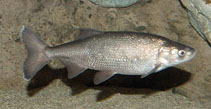| Family: |
Leuciscidae (Minnows), subfamily: Laviniinae |
| Max. size: |
36 cm TL (male/unsexed); max. reported age: 6 years |
| Environment: |
demersal; freshwater |
| Distribution: |
North America: Sacramento-San Joaquin, Clear Lake, Russian River, and Pajaro-Salinas river drainages in California, USA. Three subspecies were previously recognized: Lavinia exilicauda chi in Clear Lake; Lavinia exilicauda harengus in Pajaro and Salinar River; and Lavinia exilicauda exilicauda in rest of the range. |
| Diagnosis: |
Dorsal soft rays (total): 10-13; Anal soft rays: 11-13. Body deep and compressed; caudal peduncle tapering to narrow; caudal fin large; lateral line strongly decurved; head small, compressed, mouth terminal (slightly upturned); dorsal-fin origin behind pelvic-fin origin; scales on lateral line 54-62; dorsal fin with 10-13 rays; anal fin with 11-13 rays; pharyngeal teeth 0,5-4,0 or 0,5-5,0; brown-yellow above, scales on back and silver side darkly outlined (crosshatched pattern on small individuals); fins dusky; and small specimens with black caudal spot (Ref. 86798). |
| Biology: |
Occurs in lakes, ponds, sloughs, backwaters and sluggish sandy pools of small to large rivers (Ref. 5723, 86798). |
| IUCN Red List Status: |
Least Concern (LC); Date assessed: 24 February 2012 Ref. (130435)
|
| Threat to humans: |
harmless |
Source and more info: www.fishbase.org. For personal, classroom, and other internal use only. Not for publication.

